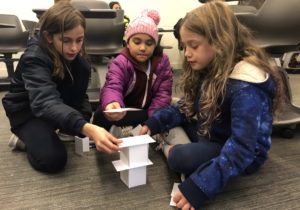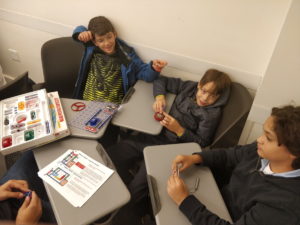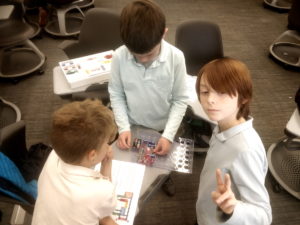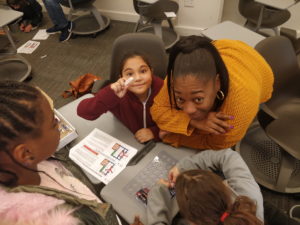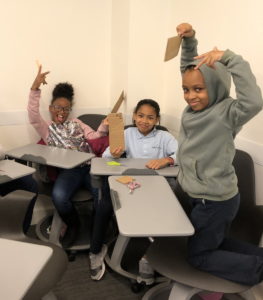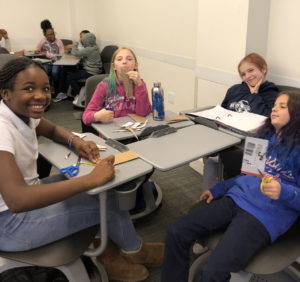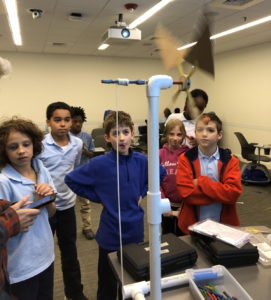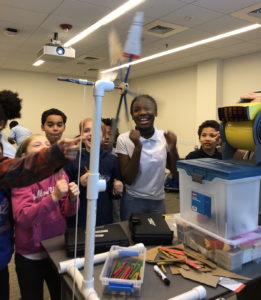Today, 40 fourth grade students from the Mendell Elementary School came for a field trip to Northeastern. Northeastern University and the Mendell have worked together for many years, both with visits to Northeastern for STEM field trips, but also through the Excellence for All Robotics Program: from 2016-2019, student volunteers from Northeastern came to the Mendell to teach Lego robotics to fourth/fifth grade students at the Mendell.
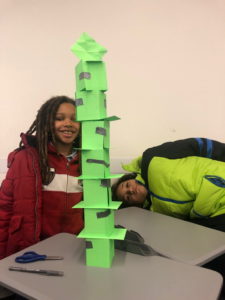
Tower with a spire – standing at 26.5 inches
During this field trip, students learned about engineering and the design process (EDP), as well as about renewable energy and circuits. Using the steps of the EDP (Ask, Imagine, Plan, Create, Improve), the students built and improved paper tower designs, first to hold a weight off the ground, and then to be as tall as possible. Although some towers were unable to support the weight challenge – others did so successfully. It’s important to note that failure is a huge part of engineering: designs aren’t (usually) perfect the first time around – engineers need to persevere and keep trying, improving till they arrive at a final product. As Edison once said: “I have not failed. I’ve just found 10,000 ways that won’t work.” The tallest towers were ~26 inches tall, using a foot of duct tape. There was also a 25 inch design which did not use any duct tape. The secret to tall paper towers is having a spire on top of your structure – which is what real world building designers also use to make their towers just a bit taller (such as One World Trade Center, where the spire is the top 408 feet of the tower).
- Students designed towers to hold weight (a stuffed parrot) and then redesign to be as tall as possible.
Students then took turns rotating between two activities. One activity was Snap Circuits, in which students learned about circuits and then had a hands-on opportunity to make some of their own circuits, using batteries, switches, motors, sound boards, and wires. Important concepts learned were series and parallel circuits and that the direction of energy flow is important (positive and negative polarity) to a circuit.
- Students use Snap Circuits to build and learn about various circuits
- Students build a circuit to spin a fan blade – and then launch it into the air.
- Students build their circuits following an instruction booklet, as well as their own creations.
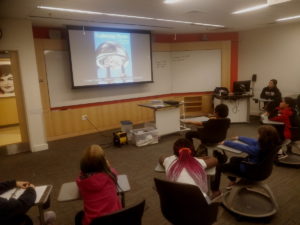 The other activity students participated in was Wind Turbines. Students learned about how the wind is used by humans, plants, and animals, and how we can harness the wind to generate electricity. Students learned about William Kamkwamba, who, as a young student, built his own wind turbine from scraps in a small village in Malawi, generating electricity to power four light bulbs and a radio. Wind energy is often considered the energy of the future, but it’s important to note that individual wind turbines don’t actually generate that much power. Commercial scale wind turbines are HUGE, and often exist in wind “farms”, with 100s to 1000s of wind turbines in each farm. In this activity, students designed wind turbine blades from cardboard and generated power as well, albeit at a much smaller scale. Using some simple physics equations, we were able to calculate exactly how much power was generated by their designs – the best design was able to generate 73.25 watts of power, enough to power 1 incandescent light bulbs. Our collected wind turbine data can be found here: Wind Turbine Power Graphs.
The other activity students participated in was Wind Turbines. Students learned about how the wind is used by humans, plants, and animals, and how we can harness the wind to generate electricity. Students learned about William Kamkwamba, who, as a young student, built his own wind turbine from scraps in a small village in Malawi, generating electricity to power four light bulbs and a radio. Wind energy is often considered the energy of the future, but it’s important to note that individual wind turbines don’t actually generate that much power. Commercial scale wind turbines are HUGE, and often exist in wind “farms”, with 100s to 1000s of wind turbines in each farm. In this activity, students designed wind turbine blades from cardboard and generated power as well, albeit at a much smaller scale. Using some simple physics equations, we were able to calculate exactly how much power was generated by their designs – the best design was able to generate 73.25 watts of power, enough to power 1 incandescent light bulbs. Our collected wind turbine data can be found here: Wind Turbine Power Graphs.
- Students design their own wind turbine blades – variables include shape, size, and number of blades.
- Students cutting out wind turbine blades and getting ready to test their design.
- Students testing their wind turbine blades. The yellow dowels, which connect the blades to the rotor, were the shortest choice and ultimately one of the best.
- A large blade design – the larger the blades, the more power, but also the more air resistance to deal with.

